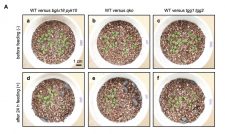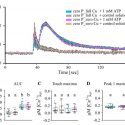Identification of Leaf ER Bodies in Arabidopsis
Endoplasmic reticulum bodies (ER bodies) are endoplasmic reticulum-derived organelles specific to the order Brassicales that are thought to play a role in plant defense against biotic factors. ER bodies are generally classified into two types: 1.) constitutive ER bodies that are found in the epidermal cells of seedlings and 2.) wound-inducible ER bodies that are formed in wounded rosette leaves. ER bodies accumulate two types of β-glucosidases: PYK10, the constitutive ER-body β-glucosidase; and BETA-GLUCOSIDASE18 (BGLU18), the wound-inducible ER-body β-glucosidase. PYK10 exhibits myrosinase activity toward indole-3-ylmethyl glucosinolate (I3G). Glucosinolates are a group of  secondary metabolites specific to the order Brassicales that are degraded to toxic compounds such as isothiocyanates and nitriles by myrosinases. Glucosinolates and myrosinases are accumulated separately in intact tissues but combine when these tissues are damaged as a result of herbivory, thus allowing the hydrolysis reaction to occur. This reaction, called the “mustard oil bomb,” is an effective defense against various small herbivores. Nakazaki et al. (10.1104/pp.18.00984) now reveal the occurrence of a third type of ER body in Arabidopsis rosette leaves which they term “leaf ER bodies” (L-ER bodies). L-ER bodies occur constitutively in three cell types found in rosette leaves, namely marginal cells, the epidermal cells covering the midrib, and giant pavement cells. L-ER bodies were seldom observed in nai1 mutant leaves, indicating that NAI1 is involved in L-ER body formation. Mutant analyses indicate that BGLU18 and PYK10 are the major components of L-ER bodies. Assays revealed that bglu18 pyk10 leaves were defective in hydrolyzing glucosinolates and were preferentially fed upon by a species of herbivorous isopod. Overall, these results indicate that L-ER bodies play an important role in the defense against herbivory in Arabidopsis leaves.
secondary metabolites specific to the order Brassicales that are degraded to toxic compounds such as isothiocyanates and nitriles by myrosinases. Glucosinolates and myrosinases are accumulated separately in intact tissues but combine when these tissues are damaged as a result of herbivory, thus allowing the hydrolysis reaction to occur. This reaction, called the “mustard oil bomb,” is an effective defense against various small herbivores. Nakazaki et al. (10.1104/pp.18.00984) now reveal the occurrence of a third type of ER body in Arabidopsis rosette leaves which they term “leaf ER bodies” (L-ER bodies). L-ER bodies occur constitutively in three cell types found in rosette leaves, namely marginal cells, the epidermal cells covering the midrib, and giant pavement cells. L-ER bodies were seldom observed in nai1 mutant leaves, indicating that NAI1 is involved in L-ER body formation. Mutant analyses indicate that BGLU18 and PYK10 are the major components of L-ER bodies. Assays revealed that bglu18 pyk10 leaves were defective in hydrolyzing glucosinolates and were preferentially fed upon by a species of herbivorous isopod. Overall, these results indicate that L-ER bodies play an important role in the defense against herbivory in Arabidopsis leaves.



